Poultry Breeds Unveiled: Traits and Insights
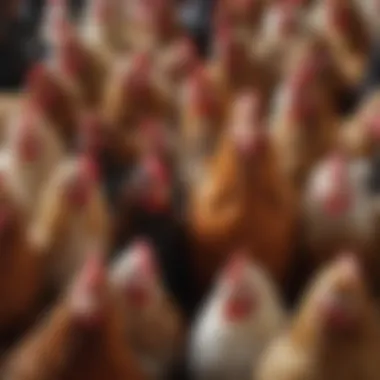
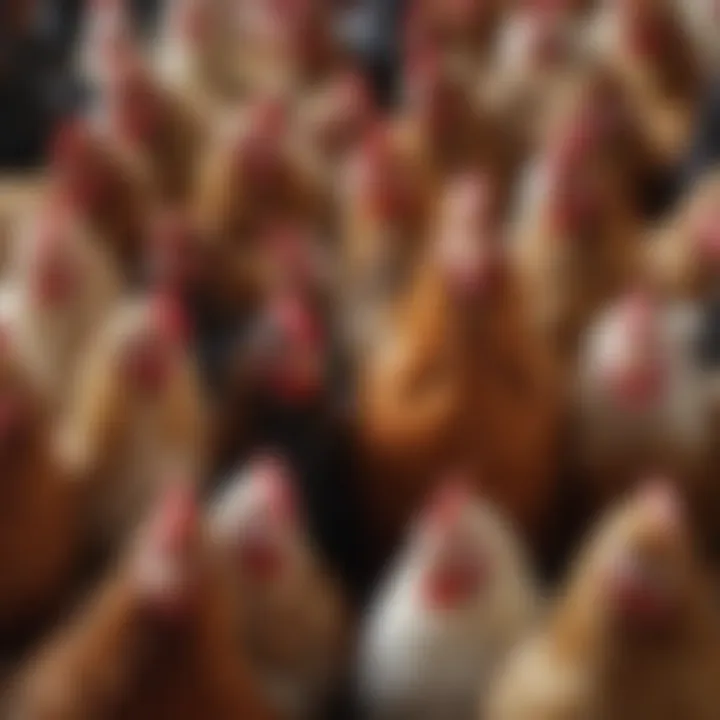
Intro
Poultry farming is an integral component of agriculture, providing not just food but also livelihoods all over the world. Chickens, ducks, turkeys, and other birds can produce meat and eggs, thus being of great importance to both local and global markets. This article explores various poultry breeds, their characteristics, and their significance in modern farming practices. It is aimed at agriculture farmers and enthusiasts who seek to deepen their understanding of poultry breeds and their specific traits.
Topic Overview
Definition and Importance
Poultry breeds encompass a variety of domesticated birds raised for meat, eggs, and feathers. These breeds exhibit distinct characteristics that affect their adaptability to different environments and their productivity. For instance, some breeds are known for their prolific egg-laying capabilities, while others are valued for their robust meat yield. Understanding these characteristics is crucial for farmers as it influences breed selection, which can impact overall farm productivity and sustainability.
Brief History and Evolution
The domestication of poultry dates back thousands of years. Originally, wild birds were captured for food, but over time, selective breeding birthed the various breeds we see today. The domestication of chickens is particularly notable, with evidence suggesting that it began over 5,000 years ago in Southeast Asia.
In the following centuries, traits such as size, egg production, and temperament were refined through breeding. This evolution has led to a diverse range of poultry breeds suited for different climates and farming methods. Farmers can now choose breeds based on desired characteristics, whether they be resilience, productivity, or adaptability to local conditions.
Key Techniques and Innovations
Sustainable Farming Practices
Sustainability is at the forefront of modern poultry farming. Utilizing organic practices, rotational grazing, and integrated pest management are ways farmers can achieve better results while minimizing environmental impact. Chickens, for instance, can play a role in pest control and fertilization if managed properly, leading to healthier soil and better crop yields.
Advanced Agronomic Technologies
The integration of technology in poultry farming is transforming the industry. Innovations such as precision farming help optimize feed conversion rates, monitor bird health, and improve overall productivity. Tools like automated feeders and climate control systems exemplify how technology can enhance poultry farming, making it more efficient and productive.
Practical Applications
Step-by-Step Guides
- Selecting the Right Breed: Assess your goals—what do you want: meat, eggs, or both? Research breeds that align with your production needs.
- Creating a Suitable Environment: Ensure your poultry has adequate space, temperature regulation, and clean water.
- Monitoring Health and Nutrition: Provide a balanced diet and stay vigilant about any signs of illness during monitoring.
Case Studies or Real-World Examples
In a recent study conducted at a local farm in Iowa, the owner transitioned from traditional poultry breeds to using hybrid varieties. The hybrid birds produced 20% more eggs while requiring less feed. This case demonstrates how understanding breed characteristics can lead to improved productivity.
Understanding breed characteristics is essential for optimizing productivity and ensuring sustainable practices in poultry farming.
Prolusion to Poultry Breeds
Understanding poultry breeds is essential for anyone involved in poultry farming. Breeds influence not just the type of birds raised but their behavior, productivity, and adaptability to various environments. As the industry grows, knowing which breeds best suit specific farming goals becomes increasingly important.
Definition and Importance
Poultry breeds refer to the specific types of domestic birds such as chickens, ducks, and turkeys, each distinguished by unique characteristics including size, coloration, egg or meat production, and temperament. The importance of defining these breeds lies in their direct impact on farming practices and outcomes. For instance, laying hens like the Leghorn are chosen for high egg production, while broilers such as the Ross are selected for meat yield. Selecting the right breed can maximize efficiency and productivity in poultry farming, ultimately affecting economic viability. With the global rise in poultry consumption, understanding these definitions helps farmers cater to market demands effectively.
The Role of Breeds in Poultry Farming
Breeds play a crucial role in poultry farming. They determine not only the production capacity but also the adaptability to local climates. For example, some breeds thrive in colder climates, making them suitable for regions with harsh winters. Conversely, others show greater resilience in warmer environments. Here, understanding breed characteristics is important.
Moreover, some poultry breeds are bred for specific traits such as disease resistance and growth rate, contributing to overall farm sustainability. This knowledge enables farmers to make informed decisions based on their goals, whether that is for commercial egg production or meat harvesting. Overall, breed selection is vital for optimizing yield, ensuring animal welfare, and maintaining sustainability in poultry farming.
Classification of Poultry Breeds
Classification of poultry breeds plays a vital role in understanding the diverse world of poultry farming. It provides a framework that helps farmers and enthusiasts identify the different types of breeds available and their individual characteristics. This classification is crucial for making informed decisions regarding breed selection, which can greatly impact productivity and adaptability in the farming environment. A systematic understanding can optimize breeding practices and enhance the overall success of poultry operations.
Commercial vs. Heritage Breeds
The distinction between commercial and heritage breeds is significant in poultry farming.
Commercial breeds are primarily designed for high productivity. These birds are selectively bred to excel in specific traits such as fast growth rates and high egg production. A prime example is the Cobb 500 broiler, known for its outstanding meat yield. Farmers often prefer these breeds for their economic benefits, as they can achieve higher returns on investment.
In contrast, heritage breeds are valued for their historical significance and genetic diversity. These breeds, such as the Rhode Island Red, are often hardier and show a greater ability to adapt to varying environmental conditions. They may not reach the same production levels as commercial breeds but offer benefits such as better taste and quality of the products. Heritage breeds are also admired for their ability to thrive in pasture-based or free-range systems, providing a more sustainable and ecologically friendly approach to poultry farming.
"Choosing the right type of breed can dictate not only the economic success of a poultry enterprise but also its sustainability and resilience."
Dual-Purpose Breeds
Dual-purpose breeds serve both meat and egg production needs. This classification is beneficial for farmers looking to maximize their resources without specializing in one aspect of poultry farming. Breeds like the Plymouth Rock are well-known for their balanced capabilities. They produce a decent number of eggs while also providing good-quality meat.
Utilizing dual-purpose breeds allows farmers to maintain a flexible operation, adjusting to consumer demands and market changes. They can pivot between meat or egg sales without the need for extensive changes in their flock. Moreover, dual-purpose birds typically exhibit hardiness, making them suitable for various climates and housing environments, further benefiting adaptability and resilience in poultry farming.
Choosing dual-purpose breeds caters well to small-scale farms or those aiming for self-sufficiency. By understanding the characteristics and benefits associated with each classification of poultry breeds, farmers can make more strategic decisions that align with their production goals.

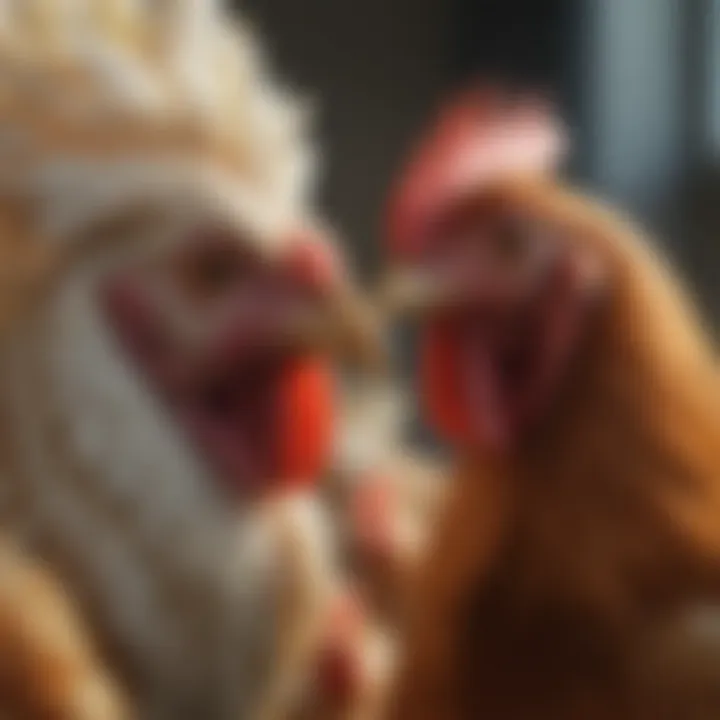
Common Poultry Breeds
The topic of common poultry breeds is vital in understanding the dynamics of poultry farming. Each breed has unique characteristics that impact their performance in production systems. Recognizing these breeds can assist farmers in making informed decisions that directly relate to productivity and sustainability.
Broilers
Broilers are chickens specifically bred for meat production. They are known for their rapid growth.
Growth Rate
The specific aspect of growth rate is crucial for broilers. This characteristic determines how quickly the birds reach market weight. A high growth rate is essential for maximizing profits in meat production. Broilers typically attain a harvest weight in about six to seven weeks, which is significantly faster than traditional breeds. This efficiency is a key reason for their popularity among farmers.
The unique feature of the growth rate is linked to genetics. Most broiler breeds have been developed through selective breeding to enhance their weight gain and muscle development. However, the rapid growth can lead to health complications, such as leg disorders, if not properly managed or if they are grown in unsuitable environments.
Feed Efficiency
Feed efficiency refers to the amount of feed required for broilers to gain weight. This statistic plays a significant role in achieving economic viability in poultry farming. Broilers are bred to convert feed into body mass effectively, reducing overall feed costs for farmers.
The key characteristic of feed efficiency is that it allows for higher returns on investment. Farmers benefit from spending less on feed while achieving desirable growth in their flocks. However, the balance between feed efficiency and maintaining the health of the birds must be carefully managed since an excessive focus solely on rapid growth can lead to metabolic disorders.
Layers
Layers are breeds of chickens primarily raised for egg production.
Egg Production Rates
Egg production rates are a critical factor for layers. These rates determine how many eggs a hen will lay within a specific timeframe. High production rates generally means more income for poultry farmers. Specialized laying breeds can produce over 300 eggs annually, contributing significantly to the chicken industry.
The uniqueness of these egg production rates stems from selective breeding. Layers such as the White Leghorn are known for their high productivity. However, maintaining high production rates requires careful management of factors like nutrition and housing conditions to ensure hens remain healthy and produce optimally.
Egg Quality
Egg quality is another major aspect of layers. Quality encompasses various factors, including shell strength, yolk color, and overall freshness. High-quality eggs have specific market values and can attract premium prices.
The key characteristic of egg quality is its direct correlation with consumer preferences. Many consumers today seek organic or free-range eggs, pushing farmers to select breeds that can produce superior quality eggs under specific rearing conditions. Nonetheless, achieving optimal quality can often necessitate higher production costs, presenting a challenge for some farmers.
Ducks
Ducks are versatile poultry that can be raised for both meat and egg production.
Meat vs. Egg Production
When considering meat versus egg production, ducks offer varied benefits. Some breeds, like the Pekin duck, are favored for meat due to their rapid weight gain. Others, such as the Khaki Campbell, are recognized for their exceptional egg-laying capabilities.
The decision between meat and egg production can depend on market demands and personal preferences, making it essential for farmers to evaluate their economic goals before selecting duck breeds. Each type has unique features that can cater to specific production goals, but understanding local demand is key to maximizing benefits.
Adaptability
Adaptability is a significant trait in duck breeds. Ducks are often more tolerant of varying environmental conditions compared to chickens. Some ducks thrive in marshy areas while others prefer drier environments.
The unique feature of adaptability ensures that farmers can raise ducks in diverse climates. This resilience can provide farmers flexibility when designing their production systems. However, it is important to select specific breeds that best meet local environmental conditions for optimal production.
Characteristics of Popular Breeds
Understanding the characteristics of popular poultry breeds is key for smarter poultry farming practices. By examining these traits, farmers can make informed decisions that enhance productivity and animal welfare. This section details several popular breeds, illustrating their unique advantages and contributions to poultry farming.
Rhode Island Red
Hardiness
The hardiness of the Rhode Island Red breed is one of its most significant traits. This breed can withstand challenging weather conditions, from extreme heat to freezing temperatures. Their robust constitution reduces mortality rates and ensures consistent production levels. Farmers often choose this breed for its adaptability to various environments, which can lead to a more sustainable farming operation. Moreover, their capacity to thrive in less than ideal conditions allows them to continue producing eggs and meat. However, even with their resilience, proper care and management remain essential for optimal health.
Egg Production
Rhode Island Reds are known for their impressive egg-laying capabilities. They provide a substantial quantity of large, brown eggs throughout the year. This characteristic makes them a popular choice for farmers focused on egg production. The breed’s consistent output means that farmers can expect a reliable supply of eggs. Additionally, their ability to lay eggs even in less favorable conditions is a key advantage. But it is important to note that factors such as diet and living conditions can impact overall egg production rates.
Plymouth Rock
Temperament
The Plymouth Rock breed is recognized for its friendly temperament. This trait contributes to a more manageable flock, which is crucial for those engaging in backyard farming or small-scale operations. Their easy-going nature allows for better interactions with humans and reduces stress during handling. The breed's docility makes them an excellent choice for families or novice farmers. However, their calm behavior can lead to issues such as bullying if introduced to more aggressive breeds.
Production Efficiency
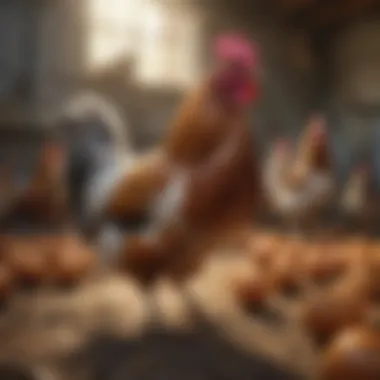
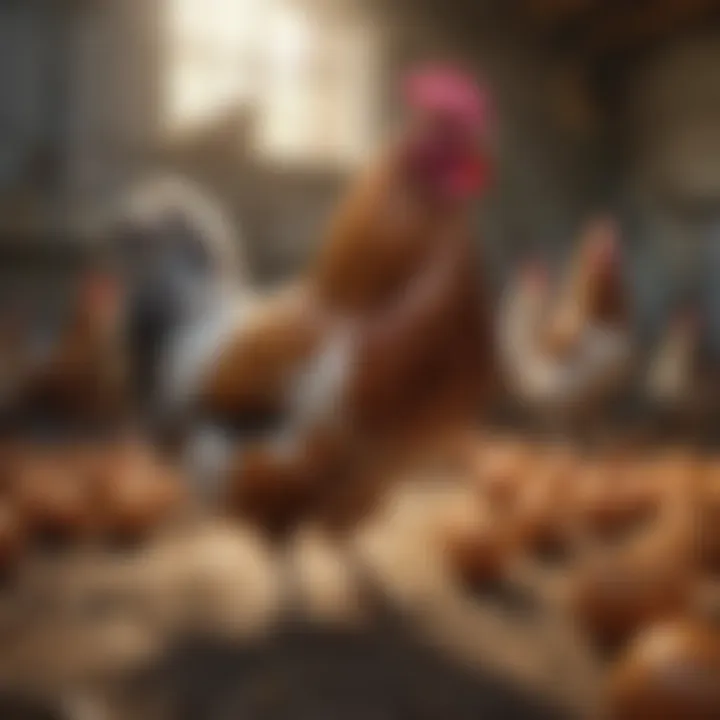
In terms of production efficiency, Plymouth Rocks stand out for their ability to convert feed into body mass and eggs effectively. This efficiency allows farmers to maximize output while minimizing feed costs, making them a financially sensible option. Their dual-purpose nature means they provide both meat and eggs, which adds to their appeal. However, it's worthwhile to ensure they receive adequate nutrition for optimal productivity, as insufficient feed can hinder their efficiency.
Leghorn
High Egg Production
Leghorns are renowned for their high egg production rates. This breed is considered one of the top layers, often yielding more than 300 eggs per year. Farmers interested in maximizing egg output typically favor Leghorns. Their efficiency in converting feed into eggs also makes them a cost-effective option for large-scale operations. However, their prolific laying can sometimes strain their health if not properly managed.
Feed Conversion
Feed conversion in Leghorns is another commendable characteristic. They are efficient feed converters, meaning they require less feed to produce a large quantity of eggs compared to other breeds. This efficiency can enhance profitability for farmers. However, it must be noted that keeping them in a balanced diet is vital. Poor feed quality can adversely affect their health and egg production.
Leghorns are exemplary for those looking for high production with lower feed costs, illustrating how breed characteristics can align with agricultural goals.
Behavioral Traits of Poultry Breeds
Understanding the behavioral traits of poultry breeds is crucial for effective management and successful farming practices. These traits influence how birds interact with their environment and their caretakers. Recognizing the behavioral patterns can help farmers make informed decisions regarding housing, handling, and breeding strategies. Managing behavior not only impacts the wellbeing of the birds but can also have significant implications for productivity and efficiency.
Social Behaviors
Poultry are inherently social animals. Their social structures can be quite complex, impacting their overall health and production capabilities. The social dynamics of poultry can be best understood through the lens of flock behavior.
- Flock Formation: Chickens tend to establish a hierarchy, often referred to as the pecking order. This hierarchy helps reduce conflicts within the group by designating roles. Breeds like the Rhode Island Red show distinct social behavior as they tend to be more dominant in a flock.
- Communication: Poultry utilize a range of vocalizations and body language to communicate with each other. Understanding these signals can help farmers monitor the health of the flock and identify distress or discomfort. For example, consistent clucking can signify contentment, while aggressive crows may indicate competition for pecking orders.
- Social Interaction: Some breeds are more gregarious than others. Breeds may vary significantly in their willingness to interact with other birds. Plymouth Rock chickens, known for their friendly nature, often integrate well in mixed flocks, while other breeds may be more solitary.
Temperament and Handling
The temperament of poultry breeds profoundly affects their handling and care requirements. Understanding the temperament traits helps farmers manage their flocks more efficiently while minimizing stress.
- Disposition: Some breeds like the Leghorn are known for their active and sometimes skittish nature. Farmers must adapt their handling techniques to accommodate such breeds to avoid unnecessary stress, leading to injuries or health issues.
- Stress Responses: Poultry display various stress responses that can be shaped by their temperament. Aggressive breeds may peck at handlers, while those with calmer temperaments, like the Silkie, typically exhibit more docile behavior. Recognizing these traits allows farmers to develop appropriate interaction strategies.
- Training and Socialization: Early socialization strategies enhance the handling experience for both birds and farmers. Exposing young chicks to human interaction fosters a more manageable adult bird. Compliance in handling also leads to improved productivity, as stress can reduce egg production and growth rates.
Understanding the behavioral traits of poultry is essential for creating suitable housing, managing flock dynamics, and ensuring overall wellbeing.
Environmental Adaptations
Environmental adaptations are crucial for the well-being and productivity of poultry breeds. Different breeds exhibit varying characteristics that enable them to thrive under specific environmental conditions. Understanding these adaptations is essential for farmers and enthusiasts to select breeds that will perform well in their local climate. This section examines the key aspects of climate resilience and housing requirements, both of which significantly influence the overall success of poultry farming.
Climate Resilience
Cold weather adaptability
Cold weather adaptability refers to a breed's ability to withstand low temperatures and harsh winter conditions. This characteristic is vital for regions where temperatures can plummet. Breeds like the Rhode Island Red and Sussex have feathers that provide insulation against the cold. These breeds not only survive but also continue to produce eggs or grow steadily despite the chilly environment. This adaptability can lead to lower heating costs for farmers while ensuring consistent production.
The unique feature of cold weather adaptability is the development of a dense layer of body feathers that traps heat. However, this does demand additional care. Farmers need to provide proper housing that shields birds from extreme winds and moisture. Failing to consider this can adversely affect their health and productivity.
Heat resistance
Heat resistance highlights a breed's capability to survive and thrive in high-temperature environments. Breeds such as the Leghorn and Ancona are known for their heat tolerance. This ability enables them to maintain productive levels of egg and meat production even in sweltering conditions. With climate change affecting weather patterns, heat-resistant breeds are becoming increasingly valuable.
A notable characteristic of heat resistance is the breed's capacity to dissipate heat effectively. This could come from lighter feathering and efficient metabolism, which reduce body heat. There can be drawbacks, though; some heat-tolerant breeds may have lower feed conversion rates. Selecting the right breeds can foster productivity despite challenging climates.
Housing Requirements
Housing requirements are a fundamental aspect of poultry farming that goes hand-in-hand with breed selection. Adequate housing promotes not only animal welfare but also optimal productivity. Understanding space needs and ventilation considerations is critical for farmers aiming to maintain a healthy flock.
Space needs
Space needs encompass both the physical area required for each bird and the overall housing layout. Adequate space plays a crucial role in preventing stress and promoting healthy behaviors. Overcrowding can lead to increased aggression and the spread of diseases. Providing birds with sufficient room to move reduces these risks significantly.
A recommended space allocation is about 4 square feet per bird in the coop and 10 square feet in the outdoor run for larger breeds. This ensures that they can exhibit natural behaviors. Limited space can lead to health issues, impacting overall productivity.
Ventilation considerations
Ventilation considerations are equally important in poultry housing. Proper airflow prevents the buildup of harmful gases, such as ammonia, and helps maintain a comfortable temperature. Good ventilation also reduces humidity levels, which are crucial for preventing respiratory ailments in poultry.
Farmers should ensure that ventilation systems can cope with changes in weather. For instance, during warmer months, increased airflow may be necessary, while in winter, it may need regulation to conserve heat. Poor ventilation can lead to health problems for the flock or reduced productivity.
Proper environmental adaptations, including climate resilience and housing requirements, are essential for the sustainable success of poultry farming.
Understanding these key elements can greatly assist in selecting the right breeds and making informed management decisions.
Impact of Breeds on Productivity
Understanding the impact of poultry breeds on productivity is crucial for anyone involved in poultry farming. The breed of poultry directly influences not just efficiency, but also the economic viability of the farm. From meat and egg production to adaptability, each breed comes with specific characteristics that can either optimize or hinder overall productivity.
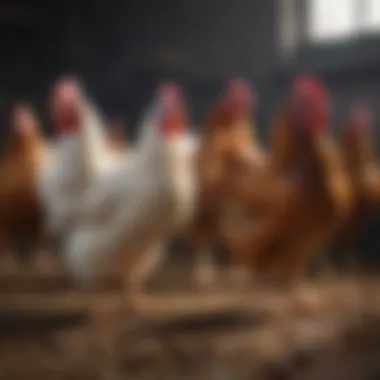
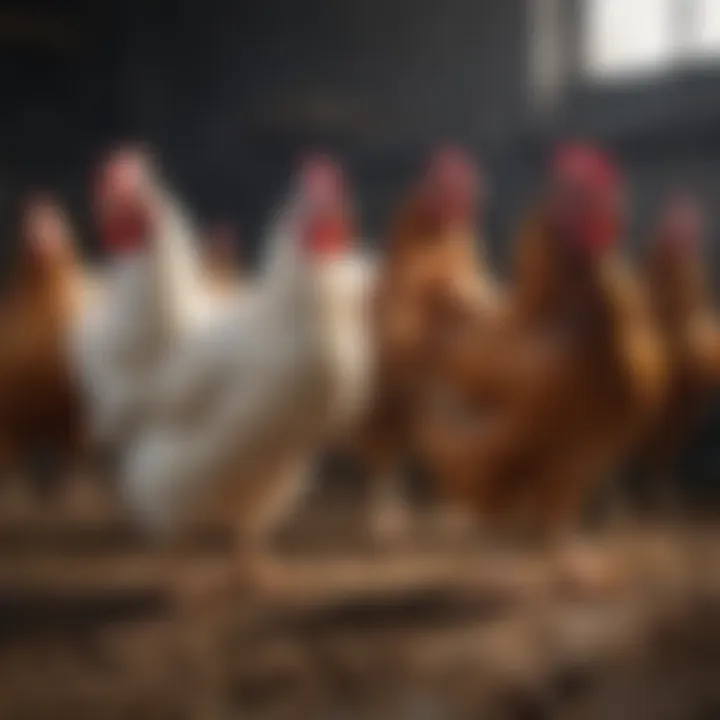
Different breeds are bred for specific purposes, and recognizing these distinctions can lead to better fulfillment of market demand and improved farm management. Thus, breed selection should be carefully considered to align with the objectives of the poultry operation. Moreover, the performance metrics of these breeds are vital for farmers making informed decisions.
Meat Production
When examining meat production, breeds like the Cornish Cross stand out. This breed is well-known for its rapid growth rate and efficient feed conversion. They reach market weight in a short time, which can reduce feed costs significantly. Factors like the breed's feed efficiency can influence the overall profitability of poultry farming.
- Cornish Cross is popular for its emphasis on meat yield.
- Broilers typically require less time to mature, leading to quicker returns on investment.
Features that contribute to successful meat production include:
- Body structure: The physical build of the breed often impacts growth and carcass yield.
- Feed conversion ratio (FCR): A lower ratio indicates that the bird converts feed into body mass more efficiently.
Ultimately, selecting for the right traits can mean the difference in meeting production goals and achieving better financial returns.
Egg Production
In terms of egg production, breeds like the Leghorn are particularly renowned. Not only do they produce a higher quantity of eggs, but they are also efficient in feed usage, which is critical for any laying hen operation.
Egg production breeds ensure that the yield is maximized while also keeping costs manageable. Key aspects influencing egg production include:
- Laying frequency: Specific breeds demonstrate consistent laying patterns throughout their life cycle.
- Egg quality: Factors such as shell strength, size, and nutritional value determine the marketability of eggs.
Having breeds such as the Rhode Island Red can also be beneficial as they offer good egg production alongside their hardiness and adaptability. As farmers prioritize breeds based on productivity, focusing on genetic qualities will lead to improved results and a sustainable poultry business.
"The right breed can significantly enhance both meat and egg production, creating a foundation for successful poultry farming."
In summary, the impact of breeds on productivity is extensive. Careful consideration and research into specific breeds can yield significant improvements in both meat and egg production, providing essential advantages to farmers aiming for sustainable practices and higher economic returns.
Sustainable Breeding Practices
Sustainable breeding practices are critical in modern poultry farming. These methods not only aim to improve production efficiency but also prioritize environmental health and animal welfare. As poultry farming faces challenges from climate change, disease, and market demands, incorporating sustainable practices becomes essential for long-term success.
Key elements of sustainable breeding practices include the selection of breeds that are resilient to environmental changes, the promotion of genetic diversity, and ethical breeding methods that ensure the well-being of the animals. By focusing on these aspects, farmers can create poultry operations that are both profitable and ecologically responsible.
Genetic Diversity
Genetic diversity in poultry breeds is vital for several reasons. Firstly, diverse genetic backgrounds contribute to the overall health of the flock. When poultry is genetically diverse, it is less vulnerable to diseases and environmental stressors. This is particularly important as new diseases continue to emerge. A balanced genetic pool enhances the chances of some birds having traits that allow them to thrive in challenging conditions.
Furthermore, maintaining genetic variety allows for the selection of breeds that perform better under specific local conditions. This adaptability is crucial for farmers who want to optimize their production.
Encouraging genetic diversity can be achieved through conscious breeding practices and by avoiding inbreeding. This ensures that future generations of poultry can benefit from a wide range of favorable traits, providing resilience and productivity.
Ethical Considerations
The ethical considerations surrounding poultry breeding cannot be overlooked. Ethical breeding practices involve treating animals humanely and ensuring their welfare throughout their lives. This includes providing adequate living conditions, appropriate nutrition, and veterinary care. The focus should be on enhancing the quality of life for poultry, rather than solely maximizing production outputs.
Consumers today are increasingly conscious of where their food comes from. They often prefer products that are raised ethically. As a result, farmers who prioritize ethical breeding practices can gain a competitive edge in the market. They may also benefit from rising demand for sustainably produced food.
Moreover, ethical considerations extend to the breeding process itself. Responsible breeders must avoid practices that compromise animal health. This includes selecting birds with undesirable genetic traits that lead to health problems. By emphasizing ethical standards, breeders can contribute positively to the perception of poultry farming in the broader community.
In summary, sustainable breeding practices encompass genetic diversity and ethical considerations, creating a balanced approach to poultry farming that benefits both producers and consumers.
Culmination and Future Considerations
The exploration of poultry breeds is a multifaceted topic that requires attention to various aspects that influence both farming practices and the overall productivity of poultry operations. An informed understanding of breed characteristics forms the bedrock of successful poultry farming. This article underscores the necessity of recognizing how different breeds can affect production efficiency, adaptability, and sustainability.
Considering the trends shaping the poultry industry today encourages farmers to adopt practices that are both modern and relevant. This recognition aids in maintaining genetic diversity, which is vital for thriving and resilient poultry populations. Ethical breeding practices are increasingly important in promoting animal welfare and environmental sustainability.
"Adopting sustainable practices helps ensure the long-term viability of poultry farming and the welfare of the animals involved."
Emerging Trends in Poultry Breeding
The poultry industry is evolving significantly, with new trends emerging to address challenges related to climate change, animal welfare, and consumer preferences. Innovative breeding programs are focusing on enhancing traits like disease resistance and feed efficiency. This modern approach also aims at reducing the environmental footprint of poultry farming.
Key trends include:
- Genomic Selection: This technology improves the breeding process, allowing for more precise genetics that can lead to better productivity and sustainability.
- Organic Farming Practices: There is a growing demand for organically raised poultry. This has led to a resurgence in interest in heritage breeds that thrive in free-range environments.
- Healthier Livestock: Focusing on immuno-competence helps produce birds that are naturally resistant to diseases, reducing the need for antibiotics.
Farmers must keep abreast of these developments to remain competitive and meet consumer demands effectively.
The Importance of Breed Selection
Breed selection is perhaps one of the most critical decisions in poultry farming. It directly impacts the productivity of the farm. Choosing the right breed can optimize meat or egg production, ensuring economic viability.
Several factors contribute to effective breed selection:
- Purpose of Production: Understanding the specific goals, whether for meat production, egg laying, or a dual-purpose approach, is vital in making informed choices.
- Local Adaptability: Poultry breeds should be able to flourish within the local climate and ecological conditions. This reduces management challenges and increases overall productivity.
- Market Demand: Aligning breed selection with market trends can enhance profitability. As consumer preferences shift toward organic and ethically raised poultry, selecting the appropriate breeds can cater to these emerging markets.
In summary, the future of poultry breeding not only relies on traditional knowledge but also embraces modern science and consumer awareness. The dual focus on productivity and sustainability is essential for the continuous advancement of poultry farming.



